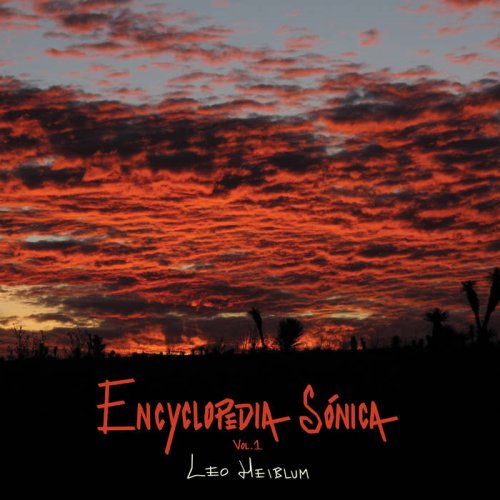
Leo Heiblum - Encyclopedia Sonica Vol. I (2024)
BAND/ARTIST: Leo Heiblum
- Title: Encyclopedia Sonica Vol. I
- Year Of Release: 2024
- Label: Language Of Sound – LOS 002
- Genre: Ambient, Experimental, Psychedelic, Jazz, Indie
- Quality: 16bit-44,1kHz FLAC
- Total Time: 47:38
- Total Size: 293 mb
- WebSite: Album Preview
Tracklist
1. The Monk & The Elephant (03:33)
2. Chis Chis (04:00)
3. Las Pelotas De Riesman (04:52)
4. Kasol (02:28)
5. Tanganazo (03:43)
6. Shamani En El Metro De Mazunte (05:07)
7. 1 (04:37)
8. Velorio (03:22)
9. Bebe Y Monos (03:46)
10. Oakland (02:53)
11. Church & Branch (04:24)
12. Chacarera (04:53)
Welcome to the Encyclopedia Sónica:
Every sound you will hear on this album has been recorded by me since 1994 in different parts of the world. On top of these sounds, their melodies and rhythms grow the compositions you will hear. Some of the pieces have a collaborator that integrates with the sounds in different ways. Since I was a little boy, I always found music everywhere. I remember listening to the engine of my mother's car and finding incredible rhythms there. I've always thought that every sound we hear can be made into music. Every sound we hear can be heard as music, felt, and understood as music. Every sound has an attack, a decay; some have a pitch. What is more beautiful - the sound of a flute, bird, trumpet, car horn, violin, or buzzing mosquito? They can all be used to make music.
If we learn to hear all sounds as 'musical', or at least having the potential to be used to make music, we might look at and listen to the world more lovingly. That car passing by had a beautiful crescendo. That dog barking in the distance created an amazing melody with an impossible-to-transcribe rhythm. Is there no creative intention behind those sounds? Can the listener give them an intention? Can the listener transform them into art?
I am just trying to organize and use them in a way that they will be musical to you, hoping that the next time you hear an ocean wave breaking, or a bonfire crackling, or a fly flying, you can enjoy the notes and the rhythms they are making. They are being created by something - who knows what the intention is, but some of the most amazing rhythms I've heard come from rocks falling in cenotes or ice breaking down in a glacier. The melodies I've listened to, from bats, dogs fighting, or newborn dogs, are haunting and beautiful. The timbre from sounds such as the thorn of a cactus, the voice of a homeless person in the street, or a mosquito buzzing can be used to create instruments as beautiful as any instrument. They have a new sound, or familiar old sound, used differently in a way that invites us to hear the music created by this planet.
I hope you enjoy these sounds...
Leonardo Heilblum
1. The Monk & The Elephant (03:33)
2. Chis Chis (04:00)
3. Las Pelotas De Riesman (04:52)
4. Kasol (02:28)
5. Tanganazo (03:43)
6. Shamani En El Metro De Mazunte (05:07)
7. 1 (04:37)
8. Velorio (03:22)
9. Bebe Y Monos (03:46)
10. Oakland (02:53)
11. Church & Branch (04:24)
12. Chacarera (04:53)
Welcome to the Encyclopedia Sónica:
Every sound you will hear on this album has been recorded by me since 1994 in different parts of the world. On top of these sounds, their melodies and rhythms grow the compositions you will hear. Some of the pieces have a collaborator that integrates with the sounds in different ways. Since I was a little boy, I always found music everywhere. I remember listening to the engine of my mother's car and finding incredible rhythms there. I've always thought that every sound we hear can be made into music. Every sound we hear can be heard as music, felt, and understood as music. Every sound has an attack, a decay; some have a pitch. What is more beautiful - the sound of a flute, bird, trumpet, car horn, violin, or buzzing mosquito? They can all be used to make music.
If we learn to hear all sounds as 'musical', or at least having the potential to be used to make music, we might look at and listen to the world more lovingly. That car passing by had a beautiful crescendo. That dog barking in the distance created an amazing melody with an impossible-to-transcribe rhythm. Is there no creative intention behind those sounds? Can the listener give them an intention? Can the listener transform them into art?
I am just trying to organize and use them in a way that they will be musical to you, hoping that the next time you hear an ocean wave breaking, or a bonfire crackling, or a fly flying, you can enjoy the notes and the rhythms they are making. They are being created by something - who knows what the intention is, but some of the most amazing rhythms I've heard come from rocks falling in cenotes or ice breaking down in a glacier. The melodies I've listened to, from bats, dogs fighting, or newborn dogs, are haunting and beautiful. The timbre from sounds such as the thorn of a cactus, the voice of a homeless person in the street, or a mosquito buzzing can be used to create instruments as beautiful as any instrument. They have a new sound, or familiar old sound, used differently in a way that invites us to hear the music created by this planet.
I hope you enjoy these sounds...
Leonardo Heilblum
Year 2024 | Jazz | Indie | Psychedelic | Ambient | FLAC / APE
As a ISRA.CLOUD's PREMIUM member you will have the following benefits:
- Unlimited high speed downloads
- Download directly without waiting time
- Unlimited parallel downloads
- Support for download accelerators
- No advertising
- Resume broken downloads


